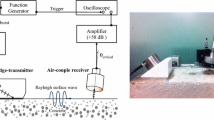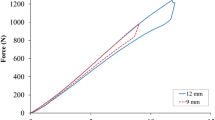Abstract
Condition or health monitoring of concrete structures has experienced increasing interest over the last decade. While conventional sensors such as strain gauges are accurate and reliable, they only allow for surface observations. In contrast, ultrasonic waves propagate through the thickness of a member and can thus detect internal changes. In this paper we present an ultrasonic monitoring approach that uses a coda wave comparison (CWC) technique, which makes use of the highly sensitive diffuse (or coda) portion of a recorded ultrasonic waveform. In this study, the changes in the applied stress were correlated to the changes observed in the ultrasonic waveforms, which were estimated using magnitude-squared coherence (MSC). The CWC technique was evaluated by investigating key influence parameters that affect the relationship between MSC and the applied stress. First, two concrete cylinders were cast and tested to study the effect of maximum aggregate size. Second, two concrete prisms were used to study the effect of the frequency of the transmitted pulse. Finally, we discuss a field test involving a prestressed concrete bridge girder and a column. The results show that MSC is capable of discriminating minute stress changes in a laboratory as well as a field setting.















Similar content being viewed by others
References
Zhang, Y., Planès, T., Larose, E., Obermann, A., Rospars, C., Moreau, G.: Diffuse ultrasound monitoring of stress and damage development on a 15-ton concrete beam. J Acoust. Soc. Am. 139, 1691–1701 (2016). https://doi.org/10.1121/1.4945097
Zhang, Y., Abraham, O., Grondin, F., Loukili, A., Tournat, V., Duff, A.Le, Lascoup, B., Durand, O.: Study of stress-induced velocity variation in concrete under direct tensile force and monitoring of the damage level by using thermally-compensated Coda Wave Interferometry. Ultrasonics 52, 1038–1045 (2012). https://doi.org/10.1016/j.ultras.2012.08.011
Hughes, D.S., Kelly, J.L.: Second-order elastic deformation of solids. Phys. Rev. 92, 1145–1149 (1953). https://doi.org/10.1103/PhysRev.92.1145
Murnaghan, F.D., Murnaghan, B.F.: Finite deformations of an elastic solid. Am. J. Math. 59, 235–260 (1937).
Planès, T., Larose, E.: A review of ultrasonic Coda Wave Interferometry in concrete. Cem. Concr. Res. 53, 248–255 (2013). https://doi.org/10.1016/j.cemconres.2013.07.009
Stähler, S.C., Sens-Schönfelder, C., Niederleithinger, E.: Monitoring stress changes in a concrete bridge with coda wave interferometry. J. Acoust. Soc. Am. 129, 1945–1952 (2011). https://doi.org/10.1121/1.3553226
Hafiz, A., Schumacher, T.: Monitoring of applied stress in concrete using ultrasonic full-waveform comparison techniques. In: Nondestructive Characterization and Monitoring of Advanced Materials, Aerospace, and Civil Infrastructure 2017. p. 101692Z. International Society for Optics and Photonics (2017)
Grêt, A., Snieder, R., Scales, J.: Time-lapse monitoring of rock properties with coda wave interferometry. J. Geophys. Res. (2006). https://doi.org/10.1029/2004jb003354
Legland, J.-B., Zhang, Y., Abraham, O., Durand, O., Tournat, V.: Evaluation of crack status in a meter-size concrete structure using the ultrasonic nonlinear coda wave interferometry. J. Acoust. Soc. Am. 142, 2233–2241 (2017). https://doi.org/10.1121/1.5007832
Snieder, R.: The theory of coda wave interferometry. Pure Appl. Geophys. 163, 455–473 (2006). https://doi.org/10.1007/s00024-005-0026-6
Payan, C., Quiviger, A., Garnier, V., Chaix, J.F., Salin, J.: Applying diffuse ultrasound under dynamic loading to improve closed crack characterization in concrete. J. Acoust. Soc. Am. 134, 211–216 (2013). https://doi.org/10.1121/1.4813847
Larose, E., Obermann, A., Digulescu, A., Planes, T., Chaix, J.-F., Mazerolle, F., Moreau, G.: Locating and characterizing a crack in concrete with diffuse ultrasound: a four-point bending test. J. Acoust. Soc. Am. 138, 232–241 (2015)
Bui, D., Kodjo, S.A., Rivard, P., Fournier, B.: Evaluation of concrete distributed cracks by ultrasonic travel time shift under an external mechanical perturbation: study of indirect and semi-direct transmission configurations. J. Nondestr. Eval. 32, 25–36 (2013). https://doi.org/10.1007/s10921-012-0155-7
Schurr, D.P., Kim, J.Y., Sabra, K.G., Jacobs, L.J.: Damage detection in concrete using coda wave interferometry. NDT & E Int. 44, 728–735 (2011). https://doi.org/10.1016/j.ndteint.2011.07.009
Moradi-Marani, F., Kodjo, S.A., Rivard, P., Lamarche, C.-P.: Effect of the temperature on the nonlinear acoustic behavior of reinforced concrete using dynamic acoustoelastic method of time shift. J. Nondestr. Eval. 33, 288–298 (2014). https://doi.org/10.1007/s10921-013-0221-9
Schurr, D.P., Kim, J.Y., Sabra, K.G., Jacobs, L.J.: Monitoring damage in concrete using diffuse ultrasonic coda wave interferometry. In: AIP Conference Proceedings. pp. 1283–1290 (2011)
Shokouhi, P.: Stress-and damage-induced changes in coda wave velocities in concrete. In: AIP Conference Proceedings. pp. 382–389. AIP (2013)
Shokouhi, P., Niederleithinger, E., Zoëga, A., Barner, A., Schöne, D.: Using ultrasonic coda wave interferometry for monitoring stress induced changes in concrete. Symp. Appl. Geophys. Eng. Environ. Probl. 2010, 650–654 (2010). https://doi.org/10.4133/1.3445493
Larose, E., Hall, S.: Monitoring stress related velocity variation in concrete with a 2 × 10−5 relative resolution using diffuse ultrasound. J. Acoust. Soc. Am. 125, 1853–1856 (2009)
Jiang, H., Zhang, J., Jiang, R.: Stress evaluation for rocks and structural concrete members through ultrasonic wave analysis. J. Mater. Civ. Eng. 29, 4017172 (2017)
Liu, S., Zhu, J., Wu, Z.: Implementation of Coda Wave Interferometry Using Taylor Series Expansion. J. Nondest. Eval. (2015). https://doi.org/10.1007/s10921-015-0300-1
Larose, E., Planes, T., Rossetto, V., Margerin, L.: Locating a small change in a multiple scattering environment. Appl. Phys. Lett. doi (2010). https://doi.org/10.1007/s10921-015-0300-1
Planès, T., Larose, E., Margerin, L., Rossetto, V., Sens-Schönfelder, C.: Decorrelation and phase-shift of coda waves induced by local changes: multiple scattering approach and numerical validation. Waves Random Complex Media. 24, 99–125 (2014). https://doi.org/10.1080/17455030.2014.880821
Niederleithinger, E., Wolf, J., Mielentz, F., Wiggenhauser, H., Pirskawetz, S.: Embedded ultrasonic transducers for active and passive concrete monitoring. Sensors. 15, 9756–9772 (2015). https://doi.org/10.3390/s150509756
Hafiz, A., Schumacher, T.: Characterizing the effect of applied stress in concrete by magnitude-squared coherence of ultrasonic full-waveforms. In: Structural Health Monitoring 2017: Real-Time Material State Awareness and Data-Driven Safety Assurance-Proceedings of the 11th International Workshop on Structural Health Monitoring, IWSHM 2017 (2017)
Grosse, C.: Quantitative zerstörungsfreie Prüfung von Baustoffen mittels Schallemissionsanalyse und Ultraschall (1996)
Chen, A., Schumacher, T.: Characterization of flaws in structural steel members using diffuse wave fields. In: AIP Conference Proceedings. pp. 761–768 (2014)
Fröjd, P., Ulriksen, P.: Detecting damage events in concrete using diffuse ultrasound structural health monitoring during strong environmental variations. Struct. Health Monit. 17, 410–419 (2018). https://doi.org/10.1177/1475921717699878
Zhang, Y., Abraham, O., Tournat, V., Le Duff, A., Lascoup, B., Loukili, A., Grondin, F., Durand, O.: Validation of a thermal bias control technique for Coda Wave Interferometry (CWI). Ultrasonics 53, 658–664 (2013). https://doi.org/10.1016/j.ultras.2012.08.003
Große, C., Schumacher, T.: Anwendungen der Schallemissionsanalyse an Betonbauwerken. Bautechnik. 90, 721–731 (2013). https://doi.org/10.1002/bate.201300074
Manolakis, D.G., Ingle, V.K., Kogon, S.M.: Statistical and Adaptive Signal Processing: Spectral Estimation, Signal Modeling, Adaptive Filtering, and Array Processing. McGraw-Hill, Boston (2000)
Cohen, J.: Statistical power analysis for the behavioral sciences, http://books.google.com/books?id=Tl0N2lRAO9oC&pgis=1 (1988)
Fröjd, P., Ulriksen, P.: Frequency selection for coda wave interferometry in concrete structures. Ultrasonics 80, 1–8 (2017). https://doi.org/10.1016/j.ultras.2017.04.012
ASTM C597-02: Standard Test Method for Pulse Velocity Trough Concrete. Annual Book of ASTM Standards. pp. 3–6 (2002). https://doi.org/10.1520/c0597-09
Acknowledgements
We would like to acknowledge the financial support from the Higher Committee of Education Development in Iraq (HCED), which funded the first author, and the Department of Civil and Environmental Engineering at Portland State University for providing laboratory equipment and specimens. Finally, we thank Mr. Salih Mahmood for assisting with the finite element model illustrated in Fig. 3.
Author information
Authors and Affiliations
Corresponding author
Rights and permissions
About this article
Cite this article
Hafiz, A., Schumacher, T. Monitoring of Stresses in Concrete Using Ultrasonic Coda Wave Comparison Technique. J Nondestruct Eval 37, 73 (2018). https://doi.org/10.1007/s10921-018-0527-8
Received:
Accepted:
Published:
DOI: https://doi.org/10.1007/s10921-018-0527-8




